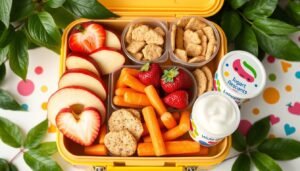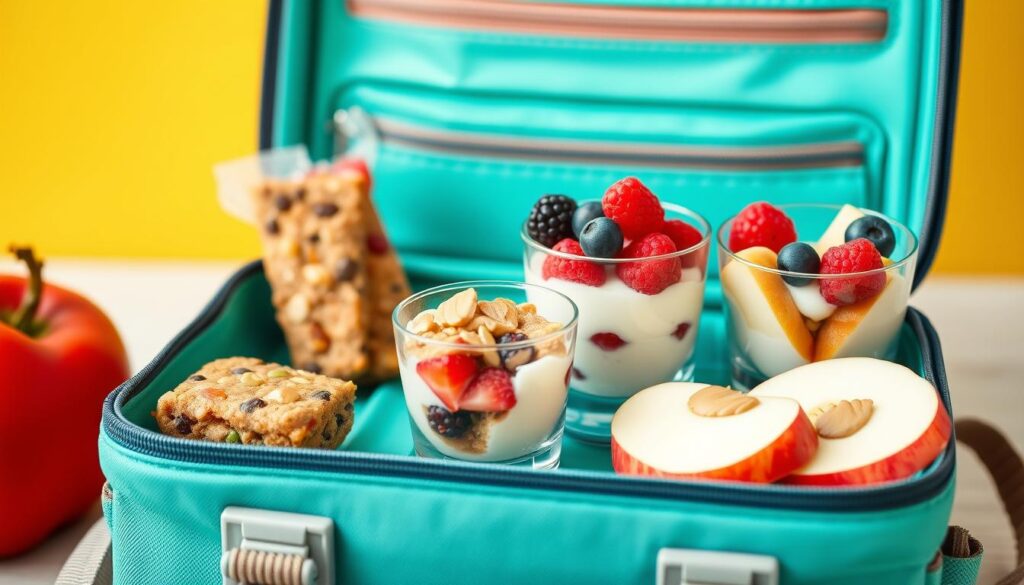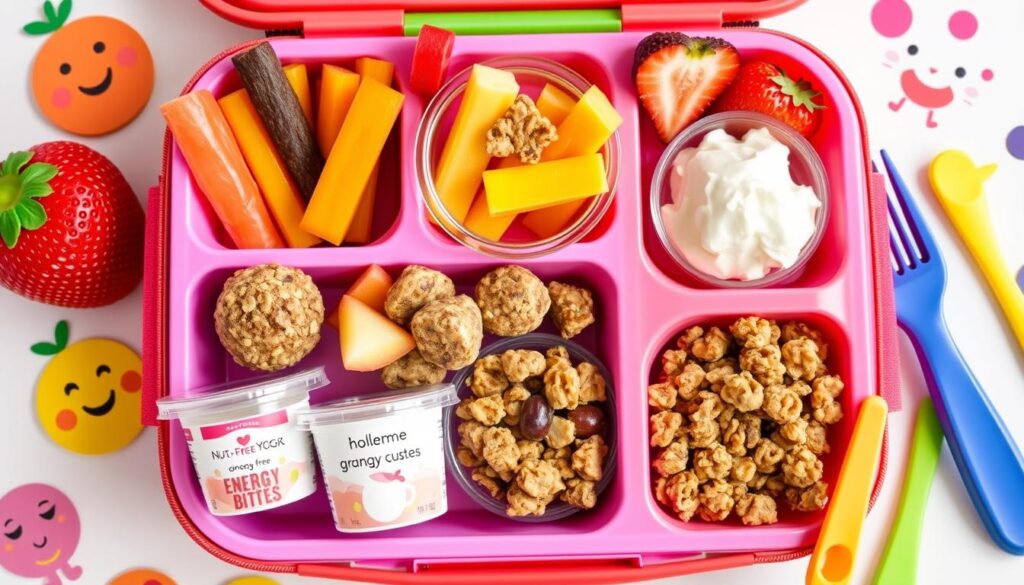The Best Fluffy Pancakes recipe you will fall in love with. Full of tips and tricks to help you make the best pancakes.

Every parent faces the daily challenge of finding snacks that are both healthy and tasty for kids. Kids use a lot of energy and need snacks every 2.5 to 4 hours. Making healthy snacks is more than just filling their lunch boxes. It’s about helping them grow, learn, and stay healthy.
Kids have small stomachs but need lots of nutrients. The right recipes can make snack time fun and nourishing. Snacks help keep their energy up, support their brains, and stop hunger crashes.
It’s important to find snacks that taste good and are good for them. This guide will show you how to make snack time both tasty and healthy for your kids.
Table of Contents
Understanding the Importance of Healthy School Snacks
Nutrition is key for your child’s growth and school success. Kids need good food to keep going all day. Lunchbox ideas and after-school treats are vital for their health and learning.
Growing kids need the right food to stay focused and full of energy. Healthy snacks can help them do better in school and feel good.
Benefits of Regular Snacking for Growing Children
- Stabilizes blood sugar levels
- Provides essential nutrients
- Supports physical and cognitive development
- Prevents mid-morning and afternoon energy crashes
Why Balanced Nutrition Matters in School Snacks
Snacks with proteins, carbs, and fats can change your child’s school day. Studies show kids with good nutrition do better in school.
| Nutritional Impact | Academic Outcome |
|---|---|
| Increased Healthy Eating Index (HEI) Scores | 10.34% improvement in dietary quality |
| Whole Grain Consumption | Positive dietary shifts post-2013 school nutrition guidelines |
| Nutrient Diversity | Better concentration and learning capacity |
The Role of Snacks in Academic Performance
“Nutrition is the single most important environmental factor affecting brain development and academic performance.”
Proper nutrition helps kids do well in math and stay in school. It also improves their social skills and thinking abilities.
Strategic snacking isn’t just about filling hunger—it’s about fueling potential.
Essential Components of a Balanced School Snack
Making healthy snacks for school is important. You need to plan carefully. A good snack should have protein, healthy fats, and fiber.
“Nutrition is the foundation of a child’s learning and development”
Let’s look at what makes a snack balanced:
- Protein: It helps the body grow and keeps blood sugar steady
- Healthy Fats: They help absorb vitamins and support the brain
- Fiber: It’s good for digestion and keeps blood sugar from rising too fast
Knowing these parts can change how you pack snacks for school. Kids who eat well do better in school. They focus better and do well on tests.
| Nutrient | Benefits | Food Sources |
|---|---|---|
| Protein | Muscle growth, stable energy | Hard-boiled eggs, lean meats, nuts |
| Healthy Fats | Vitamin absorption, brain health | Avocado, seeds, coconut, nuts |
| Fiber | Digestive health, blood sugar control | Fruits, vegetables, whole grains |
When making snacks, try to include protein, healthy fats, and fruit or veggies. This mix gives your child the nutrients they need for energy and learning.
Smart Beverage Choices for School Snacks
Choosing the right drinks for school snacks is key for your child’s health and energy. It’s important to pick healthy drinks and follow nutrition guidelines.
When making snacks at home, drinks are important for your child’s health and focus at school.
Healthy Alternatives to Sugary Drinks
It’s best to avoid sugary drinks. Here are some better options:
- Sparkling water with natural fruit essence
- Unsweetened herbal tea
- Infused water with cucumber or berries
- Club soda with a splash of 100% fruit juice
Understanding Juice Portions and Guidelines
The USDA has rules for school drinks:
| School Level | Milk/Juice Portion | Sugar Limit |
|---|---|---|
| Elementary Schools | 8 ounces | ≤ 10g added sugar |
| Middle Schools | 12 ounces | ≤ 15g added sugar |
| High Schools | 12 ounces | ≤ 15g added sugar |
The Role of Dairy and Non-dairy Options
Look for drinks that are good for growing bodies:
- Low-fat milk: Full of calcium and vitamin D
- Fortified plant-based milk
- 100% fruit juices in small amounts
“Choose beverages that nourish and energize, not just satisfy thirst.” – Nutrition Experts
By following these tips, you can pick drinks that help your child stay healthy and do well in school.
Quick and Easy Homemade Snack Ideas

Making tasty school snacks is easy. You can turn your child’s lunchbox into a healthy, energizing meal. It’s all about simple, nutritious choices.
“Healthy snacks are the secret weapon for keeping kids focused and happy at school!” – Nutrition Experts
Here are some easy, healthy recipes for kids:
- Snack Mix Magic: Mix whole grain popcorn, nuts, seeds, and dried fruit for a tasty snack
- Protein-Packed Platters: Make mini cheese and cracker plates with fresh veggies
- Dippable Delights: Try hummus with veggie sticks or sweet yogurt dips for fun
Try these creative snacks:
- Mini zucchini pizzas (just 29 calories each)
- Fruit and yogurt smoothie bowls
- Cauliflower breadsticks
- Chicken pinwheels
Busy parents, here’s a tip: Cook snacks like chickpea fritters or fruit muffins in bulk. Freeze them for quick, healthy meals. This way, you control what your kids eat.
The secret to great school snacks? Mix variety, nutrition, and fun!
Power-Packed Protein Snacks for Growing Kids
Protein is key for your child’s growth, helping muscles, brain, and health. The right snacks can boost energy and school performance.
Children need different amounts of protein as they grow. Here’s a quick guide:
- Toddlers (up to 3 years): 13 grams
- Kids (4-8 years): 19 grams
- Kids (9-13 years): 34 grams
Meat-Based Protein Options
For protein-rich lunchbox ideas, try these:
- Turkey jerky
- Hard-boiled eggs (6 grams of protein each)
- Tuna lettuce wraps
Plant-Based Protein Alternatives
Vegetarian and vegan parents have great options:
- Hummus with veggie sticks
- Chia seed pudding (2 tablespoons with ½ cup milk)
- Energy bites with 3.5 grams of protein each
Dairy Protein Selections
Dairy is a top protein source for kids:
| Dairy Option | Protein Content |
|---|---|
| Cheese Stick | 7 grams |
| Greek Yogurt (½ cup) | 7.5 grams |
| Cottage Cheese | 17 grams per bowl |
*”Small, frequent protein portions are more beneficial for children than one large serving.”*
Adding these protein sources to your child’s diet helps them do well in school and stay healthy.
Fresh Fruit and Veggie Combinations That Kids Love
Making fun school snacks with fresh fruits and veggies can change how your kid eats. Experts say making healthy snacks look good is important. It helps kids want to eat nutritious foods.
“Eating a rainbow of fruits and vegetables helps children develop diverse taste preferences and nutritional habits.”
Here are some tasty fruit mixes for healthy snacks:
- Sliced apples with almond butter
- Blueberry and banana smoothie
- Strawberry and yogurt parfait
- Mango and raspberry fruit mix
- Clementine segments with dried cranberries
Here are some tips for packing fruits in school snacks:
- Prevent apple browning by using lemon juice
- Pack berries in separate compartments to avoid crushing
- Use ice packs to keep fruits fresh
| Fruit | Nutritional Benefit | Kid-Friendly Preparation |
|---|---|---|
| Blueberries | High in antioxidants | Whole or in smoothies |
| Strawberries | Vitamin C boost | Sliced or with yogurt dip |
| Mango | Supports immune system | Diced or in fruit leather |
Remember, consistent exposure helps children develop a love for fruits and vegetables. Try different mixes to keep snacks fun and healthy!
School Snacks That Support Sustained Energy
Fueling your child’s school day needs smart snacking. This keeps energy steady and minds sharp. Knowing how nutrients work can turn snacks into powerful helpers for learning and activity.
Students need snacks that give them energy all day. Snacking tips help mix the right nutrients. This keeps focus and energy up.
Complex Carbohydrates for Lasting Energy
Complex carbs are key for lasting energy. Whole-grain foods like Ezekiel bread are great. They offer:
- 80 calories per slice
- 5 grams of protein
- Zero added sugars
Healthy Fats for Brain Function
Healthy fats boost brain power. Walnuts are the top snacks for this. They have lots of Omega-3 fatty acids, good for the brain.
Nutrition isn’t just about filling stomachs—it’s about fueling minds.
Fiber-Rich Options for Satiety
Fiber keeps students full and energy steady. Try these fiber-rich snacks:
- Seapoint Farms Dry Roasted Edamame (8 grams of fiber)
- Whole grain crackers (4-6 grams of fiber per serving)
- Homemade energy bites with oats (5 grams of fiber)
Choosing snacks with complex carbs, healthy fats, and fiber gives your child lasting energy. It also gives them the nutrients they need for school success.
Allergy-Friendly School Snack Solutions

Finding safe snacks for school can be tough for families with food allergies. With 1 in 13 kids having food allergies, making tasty and safe snacks is key for parents and schools.
“Safety doesn’t mean sacrificing taste when it comes to kid-friendly recipes for children with food allergies.”
Knowing the top allergens is the first step to safe snacks. The “big nine” allergens to watch out for are:
- Milk
- Eggs
- Peanuts
- Tree nuts
- Fish
- Shellfish
- Soy
- Wheat
- Sesame
Look for safe snack options that are healthy and safe:
| Allergen | Safe Alternatives |
|---|---|
| Peanut Butter | Sunflower seed butter |
| Milk | Coconut or almond milk |
| Wheat | Gluten-free wraps or rice cakes |
Use resources like the Safe Snack Guide, updated every 4-6 weeks. Always read labels carefully – 94% of parents with food-allergic kids check ingredient lists before buying snacks.
Here are some lunchbox ideas:
- Fresh fruit and vegetable slices
- Roasted chickpea snacks
- Homemade energy bites
- Pre-packaged applesauce pouches
Creating a safe snack space needs awareness, careful choices, and a dedication to keeping all kids safe and fed.
Mini Meal Ideas for School Time Success
Creating fun school snacks that keep kids full and happy is key. Bento-style lunch boxes have changed the game. They make it simple for parents to pack healthy, tasty mini meals that kids love.
- Use compartmentalized lunch boxes for easy meal prep
- Combine food groups for balanced nutrition
- Make bite-sized portions for easy eating
- Try new and familiar food mixes
“Involving children in lunch prep makes them more likely to eat their meals”
When making homemade snack ideas, think about these protein-rich mini-meal combos:
| Protein Source | Accompaniments | Prep Time |
|---|---|---|
| Hard-boiled eggs | Fruit slices, crackers | 10 minutes |
| Falafel bites | Hummus, veggie sticks | 15 minutes |
| Cheese cubes | Apple slices, granola | 5 minutes |
For great school snacks, use insulated lunch boxes and cut foods into kid-friendly sizes. Add variety to keep things interesting. Remember, health doesn’t have to be dull!
By focusing on balanced, appealing mini meals, you’ll meet your child’s nutritional needs. Lunchtime will become a highlight of their school day.
Conclusion: Making Healthy Snacking a Daily Habit
Changing your child’s diet takes time. It needs patience and creativity. Start with small steps to help them learn healthy eating habits.
Kid-friendly recipes can make eating fun. With 25% of kids in the U.S. being obese, it’s key to make food experiences positive. Let your kids help with snacks, offer different options, and make meals fun.
Research shows snacks can boost school performance and brain function. The USDA suggests 4.5 to 6.5 servings of fruits and veggies daily for kids. By focusing on nutrition, you teach them important life skills that prevent health problems.
Snacking can greatly benefit your child’s health. Begin with small steps, stay consistent, and remember it’s a journey. With careful planning and a positive mindset, snack time can be a chance for nutrition, learning, and bonding.
FAQ
How important are school snacks for my child’s overall development?
School snacks are key for your child’s growth. They give essential nutrients and keep energy levels up. This helps with focus and school work.
What makes a healthy school snack?
Healthy snacks mix protein, fats, carbs, and fiber. Choose whole grains with nuts, seeds, or dairy for energy. These snacks keep your child full and focused.
How can I make healthy snacks appealing to my picky eater?
Make snacks fun with colors and shapes. Let your child help with making snacks. Try new foods and dips like hummus or yogurt.
What are some allergy-friendly snack options for school?
Pick snacks without nuts, dairy, and eggs. Good choices are seed butter sandwiches, fruit, and veggie mixes. Always check labels and talk to your school about allergies.
How much protein should be in my child’s school snack?
Aim for 5-10 grams of protein per snack. Good sources are Greek yogurt, eggs, cheese, and edamame. Also, try nut-free seed butter or roasted legumes.
Are homemade snacks better than store-bought options?
Homemade snacks are better because you control what goes in them. You can avoid bad stuff like added sugars. Making snacks is fun and teaches kids about healthy eating.
What are the best beverages to pack with school snacks?
Pack water, unsweetened flavored water, low-fat milk, or 100% fruit juice. Avoid sugary drinks. Use fruit juice in small amounts and choose unsweetened options.
How can I ensure my child maintains steady energy throughout the school day?
Choose snacks with complex carbs, protein, and fats. Whole grains, fruits, veggies, nuts, seeds, and lean proteins are best. Avoid simple sugars to prevent energy drops. Opt for balanced snacks to keep your child focused.









